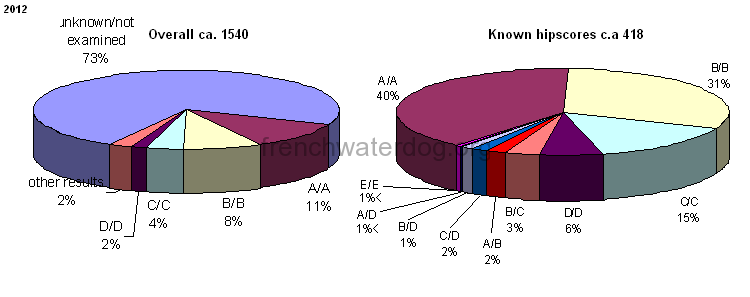Charts above represents the results of Barbet hip scores published on sites around the web. We were able to find and collect around 420 results. Although all of those results were published by owners/clubs, or send directly to us, their credibility shouldn’t be questioned. Chart on the left indicates that around 27 % of current Barbet population was x-rayed for dysplasia. From those who where tested 73 % have healthy hips (A/A,B/B and A/B*). 27 % of tested dogs have dysplasia, 11 % of them have severe dysplasia (D or lower).
Studies show that dysplasia is heritable disease, although scientists opinion varies on details. The Finnish (1) study, which focused on effectiveness of hip-dysplasia-control-program, showed that: “Our study could not support the previous studies which found significant overall decrease in disease prevalence (Brass, 1989; Swenson et al., 1997); instead, our findings support those of the studies that found distinct between-breed variation (Fluckiger et al., 1995; Willis, 1997). The effectiveness of strong official breeding restrictions is also questionable”. On the other hand British (2) study of dysplasia in labradors ends with several conclusions, with one most important ” the genetic heritability of that condition was significant from both sires and dams with higher heritability from sires”.
In the threatened breed like Barbet is, with a small gene pool, we should remember that “Hip-dysplasia screening and restrictive programs are also stated to cause a decrease in genetic variance (because of single-trait selection), which can lead to other more-severe problems (Bouw, 1982).” Of course It doesn’t mean that we should stop testing hips , quite the opposite – we should test as many as we can (also by encouraging puppy buyers, who will never breed), but we have to keep in mind that:
- B result also means that dog is healthy
- C is acceptable in most breeds around the globe (only in breeds with very big population, acceptable values are higher – like A and B in Poland in Labrador Retriever), so careful selection of parents (history of grandparents, siblings and/or other litters) with one A/A and other C/C hips should give good results – read the British Study to find out more about predicting of hipscores
- dysplasia is one of many traits (overall structure, coat quality, temperament etc.) we need to take under consideration while planning the litter and not the most important one (of course we speak about ABC results)
- D results means that dog is sick, unfortunately, we can observe a big step back in one of the countries that was a pioneer in hip-control-programs, by allowing such dogs to be breed, while the bad results can and probably will occur in the progeny. Also the mating and pregnancy can cause discomfort to the dog, which should never be overloaded.
* FCI Classification of hip-dysplasia.
A Normal No signs of dysplasia
B Borderline Healthy, with slight changes in conformation
C Mild dysplasia
D Moderate dysplasia
E Severe dysplasia
To read (studies mentioned above):
1. Controlling canine hip dysplasia in Finland (EN)
To watch:
Motion capture used to show the differences in movement between healthy and dysplastic dogs
